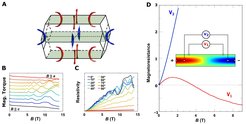Press Release: Tantalum Phosphide – Resistivity Behavior Unraveled
Scientists from the Max-Planck Institute for Chemical Physics of Solids succeeded to uncover the mysterious resistivity behavior of the semimetal tantalum phosphide (TaP) in high magnetic fields. TaP and its closely related compounds tantalum arsenide and niobium phosphide and arsenide belong to a new group of metals, so called Weyl semimetals. Like ordinary semimetals, e.g. graphite or bismuth, these metals are characterized by extremely fast moving electrons. Their Weyl electrons are classified into two groups according to their direction of propagation and magnetism. Electrons from one of these groups appear as the mirror image of electron from the other group like left and right hand. This so-called chirality of the electron is predicted to lead to a vanishing resistance in these materials if a strong magnetic field is applied parallel to the electrical current.
However, in their article, F. Arnold and C. Shekhar et al. showed, that the observed negative magnetoresistance in TaP is not caused by chiral electrons, but by a magnetic field driven focusing of electrons, producing an electron jet.
The successful collaboration of theorists and experimentalists from within the institute and the Max Planck Institute for Physics of Complex Systems under supervision of Dr. Binghai Yan and Dr. Elena Hassinger managed to unveil the electronic structure of TaP by measuring magnetization and resistivity oscillations at high magnetic fields and temperatures close to absolute zero. These so called quantum oscillations are a fingerprint of the electronic structure of a metal. In combination with additional calculations, electrical properties such as the type and density of charge carriers can be derived from these oscillations. This information enabled the scientists to show that TaP does not host any chiral electrons. Thus alternative explanations for the mysterious magnetoresistance were searched for. It was shown that a magnetic field driven electron jet, which is commonly observed in materials with high electron velocities, is responsible for this anomaly. Its presence was proven by the different resistivity behaviors of two voltage contact pairs in a parallel magnetic field.
The team from Dresden is now trying to tailor the electronic structure of TaP such, that chiral electrons become observable. This can be done e.g. by partially replacing P in TaP with other materials like arsenic or silicon. In case of success this would be the first realization of massless chiral particles since their prediction by Hermann Weyl in 1929 [1].
[1] Weyl, H. Zeitschrift Physik 56, 330–352 (1929)
FA / CPfS

Figure 1. A) shows the electronic structure of TaP. Electrons moving along the blue and red Fermi surfaces generate the magnetic torque and resistivity oscillations of B) and C). D) depicts the magnetoresistance of TaP for two different voltage contact pairs. The magnetoresistance is calculated as MR = (V(B)-V(0))/V(0). Whilst the resistance measured at the electron jet (V2) strongly increases, its counterpart at the samples surface (V1) drops quickly.
